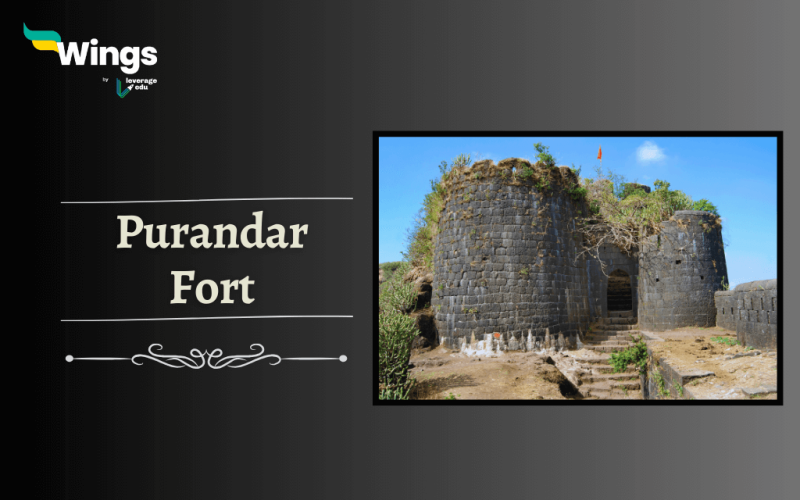Purandar Fort is located in the Pune District of Maharashtra, India. It is strategically located in the Western Ghat of the region and holds a historical significance in the region’s history. Purandar Fort history goes back to the 11th century and the fort has witnessed various battles, treaties, empires and rulers over the centuries. Let’s delve right into this architectural marvel with its features, facts and more information about Purandar Fort.
Table of Contents
| Commissioned by | Yadava Rulers |
| Location | Pune, Maharashtra |
| Timings | 9:00 am to 6:00 pm; Open Everyday |
| Entry Fee for fort | Free Entry |
| Camera | Allowed and Free |
History of Purandar Fort
Built during the Yadava dynasty in the 11th century, Purandar Fort was originally known as “Puranmadhye Gad” and served as a strategic outpost.
- Later, the Persians were believed to be the ones who completely built the fort in the year 1350 AD.
- The fort was later captured by the Bijapur and Ahmednagar Sultanate in the 14th century.
- In 1596 A.D., the Bahadur Shah of the Ahmednagar Sultanate granted two territories Pune and Supa to Maloji Bhosle who was the grandfather of Shivaji Maharaj.
- Chhatrapati Shivaji Maharaj, the founder of the Maratha Empire, seized control of Purandar Fort in 1646 A.D. after a strategic alliance with the Sultanate of Bijapur. The fort played a crucial role in Shivaji’s military campaigns and served as a stronghold against the Mughal forces.
- In 1665 A.D., the fort was besieged under the command of Jai Singh II representing the Mughal Emperor Aurangzeb.
- It was after the treaty of Purandar that the fort went to the Mughals for five years.
- Again, in the year 1670 A.D., Shivaji captured the fort again.
- The fort witnessed many treaties from the Second Treaty of Purandar, the Treaty of Salbai and the First Anglo-Maratha War.
- In the early 19th century, on 16th March 1818, the British East India Company captured Purandar Fort during the Third Anglo-Maratha War. The fort later served as a prison for eminent freedom fighters like Bal Gangadhar Tilak during the Indian independence movement.
Features of Purandar Fort
Situated at an altitude of 4,472 feet above sea level, Purandar Fort offers breathtaking panoramic views of the surrounding landscape, including lush green valleys and the Torna Fort in the distance. The fort is surrounded by large stone walls and multiple gateways, including –
- There are two levels of the fort. The lower level is called Machi and the upper level comprises Dili Darwaza and Balekilla.
- The Dilli Darwaza and the imposing Bale Killa entrance. These architectural marvels showcase the fort’s strategic importance and defensive capabilities.
- Other historical structures like the Kedareshwar temple, dedicated to Lord Shiva, and the statue of Murarbaji Deshpande, a renowned Maratha warrior are some features of the fort.
- Other features of the fort include Rameshwar Temple, Bini Darwaja and Purandeshwar Temple.
- The fort also includes remnants of ancient palaces, granaries and water reservoirs that provide insights into its past glory.
Also Read – Ranthambore Fort History: Features, Facts, Timings & More
Interesting Facts about Purandar Fort
The fort’s architecture reflects a blend of different styles, including Maratha, Mughal, and Islamic influences from its various rulers over the centuries.
- The fort is also rumoured to be the birthplace of Chhatrapati Sambhaji Maharaj, who was the son of Chhatrapati Shivaji Maharaj.
- A German prisoner named Dr. Hermann Goetz wrote extensively about the fort when he was imprisoned in the fort.
- Later in spite of their German origin, Dr Goetz published his works and worked under the British administration.
- In the tales of Purandar, it is believed that Purandar is a small broken part of the mountain “Dronagiri Parvat “, which was once carried by Hanuman in the Ramayana. And, a thousand-year-old Narayaneshwar Temple belonging to the Yadavas still is present at the base of the fort called Narayanpur.
Also Read – Mehrangarh Fort History: Features, Facts, Timings & More
Timings of Purandar Fort
The timings for visiting the Monument and watching the mesmerising views are –
| Purpose | Timings |
| Entry | 9:00 am to 6:00 pm |
| Week Entry | Everyday |
| Entry Fee | No Entry Fee |
| Camera | Free |
The fort is a popular trekking destination, attracting adventurous souls seeking both history and natural beauty. Located in the Sahyadri mountain range, the fort is surrounded by Rajgad Fort, Vajragad Fort and Torna Fort. In conclusion, the fort has stood the test of time and has witnessed several events of India’s past.
Other Attractions near Purandar Fort
| Vajragad Fort | Saswad |
| Sinhagad Fort | Lonavala and Khandala |
| Ekvira Temple | Karla Caves |
| Lohagad Fort | Kondeshwar Temple |
Relevant Blogs
That’s all about Purandar Fort history! If you want to know more about topics like this, then visit our general knowledge page! Alternatively, you can also read our blog on general knowledge for competitive exams!
 One app for all your study abroad needs
One app for all your study abroad needs













